ASM Metals HandBook Vol. 8 - Mechanical Testing and Evaluation
Подождите немного. Документ загружается.


11. J. Duffy, J.D. Campbell, and R.H. Hawley, On the Use of a Torsional Split Hopkinson Bar to Study
Rate Effects in 1100-O Aluminum, J. Appl. Mech., Vol 38, 1971, p 83–91
High Strain Rate Shear Testing
Double-Notch Shear Testing and Punch Loading
Kolsky or split-Hopkinson bar testing in compression, tension, or torsion is governed by an upper limit (on the
strain rate that can be achieved) of approximately 3000 s
-1
. However, situations arise where strain rates of
several orders of magnitude greater than this limit are expected, such as in high-speed metal forming operations
or around rapidly propagating cracks. Attempts have thus been made to modify the Kolsky bar technique for
use at strain rates in this range.
The most common method involves a drastic reduction in the effective gage length of the specimen, either by
the use of a miniaturized version of the Kolsky bar, which is generally associated with an increase in the
velocity of impact (Ref 12, 13, and 14), or by the use of specialized specimen designs. Two examples of
specialized specimen designs are the double-notch shear test and the high-speed punching test. In both, the
specimen material is subjected to a high rate of shear.
References cited in this section
12. U.S. Lindholm, Deformation Maps in the Region of High Dislocation Velocity, High Velocity
Deformation of Solids, K. Kawata and J. Shioiri, Ed., International Union of Theoretical and Applied
Mechanics Symposium, Springer-Verlag, Berlin, 1978
13. G.L. Wulf, Dynamic Stress-Strain Measurements at Large Strains, Mechanical Properties at High Rates
of Strain, J. Harding, Ed., Institute of Physics Conf. Series (No. 21), 1974, p 48–52
14. D.A. Gorham, Measurement of Stress-Strain Properties of Strong Metals at Very High Rates of Strain,
Mechanical Properties at High Rates of Strain, J. Harding, Ed., Institute of Physics Conf. Series (No.
47), 1979, p 16
High Strain Rate Shear Testing
Double-Notch Shear Testing
In double-notch shear testing, the output bar is replaced by a tube into which the input bar can slide (Fig. 4).
The lower end of the input bar and the upper end of the output tube are slotted to accommodate the thin plate
specimen (see Fig. 5) into which two pairs of notches have been cut. With an effective gage length in this
specimen of 0.84 mm (0.033 in.), a maximum shear strain rate of 40,000 s
-1
, an order of magnitude greater than
that reached in the standard Kolsky bar apparatus, has been achieved (Ref 15, 16).
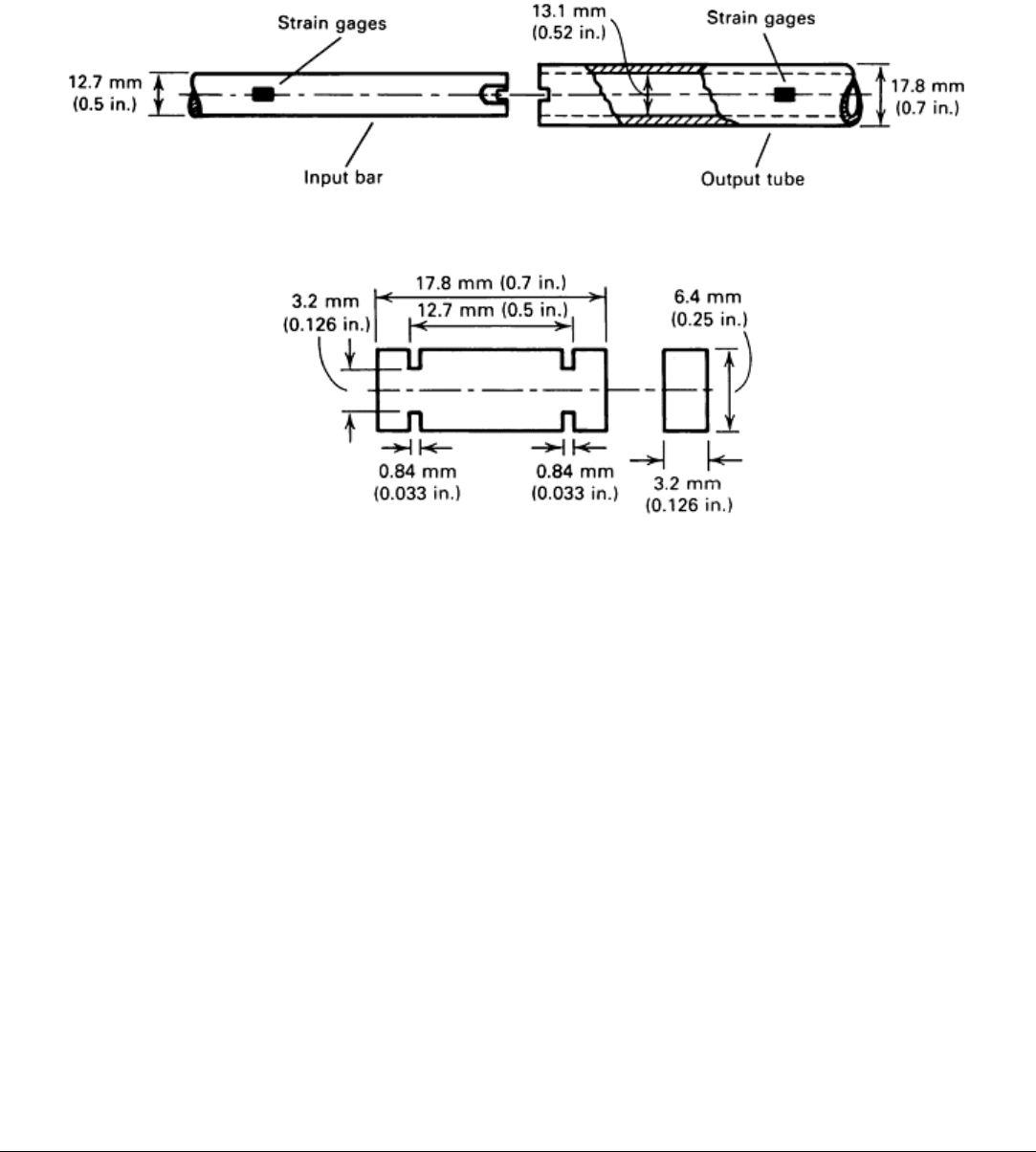
Fig. 4 Kolsky bar apparatus for double-notch shear testing at very high strain rates
Fig. 5 Double-notch shear specimen
The principal disadvantage of this technique is that at shear strains greater than about 20%, the specimen ceases
to deform in pure shear. Reliable results can only be obtained at relatively low values of shear strain (Ref 17).
Because about 20 μs are required for a constant strain rate to become established, results obtained at low strains
can only be associated with an average value of strain rate.
References cited in this section
15. W.G. Ferguson, J.E. Hauser, and J.E. Dorn, The Dynamic Punching of Metals, Dislocation Damping in
Zinc Single Crystals, Brit. J. Appl. Phys., Vol 18, 1967, p 411–417
16. J.D. Campbell and W.G. Ferguson, The Temperature and Strain Rate Dependence of Shear Strength of
Mild Steel, Philos. Mag., Vol 21, 1970, p 63–82
17. J. Harding and J. Huddart, The Use of the Double-Notch Shear Test in Determining the Mechanical
Properties of Uranium at Very High Rates of Strain, Proc. 2nd International Conf. Mechanical
Properties at High Rates of Strain, J. Harding, Ed., The Institute of Physics, London, 1979, p 49–61
High Strain Rate Shear Testing
Punch Loading
This version of the Kolsky bar is similar to the modification described above. In punch loading, however, the
specimen is a flat plate in which a circular hole is punched. A typical setup is shown in Fig. 6. Although the
clearance between the punch bar and the die tube is about 0.025 mm (0.001 in.) in Fig. 6, the effective gage
length—that is, the width of the shear zone in an actual test specimen—was found to be considerably greater.
The width of the shear zone is not very clearly defined, so in this case the quoted shear strains and strain rates
are only approximate. Estimates of the effective gage width for the test may be made by optical microscopy
with microhardness traverses across the shear zone or by comparing a derived shear stress/shear strain curve

based on an assumed gage width with the results of a conventional torsion test at a similar strain rates. Using
this technique, shear strain rates in excess of 10
4
s
-1
have been obtained (Ref 18).
Fig. 6 Punch-loading Kolsky bar apparatus
Reference cited in this section
18. A.R. Dowling, J. Harding, and J.D. Campbell, The Dynamic Punching of Metals, J. Inst. Metals, Vol
98, 1970, p 215–224
High Strain Rate Shear Testing
Shear Testing with Hat-Shaped Specimen
L.W. Meyer and L. Krüger, Materials and Impact Engineering at Technical University Chemnitz and
Nordmetall GbR, Germany
A special type of shear test configuration involves the use of a hat-shaped specimen to evaluate shear
deformation and failure of metallic materials from high shear deformation at high strain rates (Ref 19, 20, 21,
22, 23, 24, 25, 26 27, 28, 29, 30). In this method, the material is forced to shear when a hat-shaped specimen is
compressed in a Hopkinson bar or drop-weight machine. Depending on the material properties, broad or narrow
shear areas develop, which may lead to a localization or concentrated adiabatic shear failure. The main
advantage is that the shear tests can be stopped at any point of deformation, and the subsequent microstructures
developed can be investigated in detail (Ref 21, 22, 23, 24, 25, 26, 27, and 28 ). Shear stress and work of
deformation can also be estimated, because the force and displacement during shearing are measured (Ref 30,
31).
References cited in this section
19. K.-H. Hartmann, H.D. Kunze, and L.W. Meyer, Metallurgical Effects on Impact Loaded Materials,
Shock Wave and High-Strain-Rate Phenomena in Metals, M.A. Meyers and L.E. Murr, Ed., Plenum
Press, 1981, p 325–337
20. L.W. Meyer and S. Manwaring, Critical Adiabatic Shear Strength of Low Alloyed Steel under
Compressive Loading, Metallurgical Applications of Shock Wave and High-Strain-Rate Phenomena,
L.E. Murr, K.P. Staudhammer, and M.A. Meyers, Ed., Marcell Dekker, 1986, p 657–674
21. J.A. Hines and K.S. Veccio, Dynamic Recrystallization in Adiabatic Shear Bands in Shock-Loaded
Copper, Metallurgical and Materials Application of Shock Wave and High-Strain-Rate Phenomena,
L.E. Murr, K.P. Staudhammer, and M.A. Meyers, Ed., Elsevier Science B.V., 1995, p 421–428
22. F.D.S. Marquis, M.A. Meyers, Y.J. Chen, and D.S. Kim, High-Strain, High-Strain-Rate Of Tantalum,
Metall. Mater. Trans. A, Physical Metallurgy and Materials Science, Vol 26 (No. 10), 1995, p 2493–
2501
23. S. Nemat-Nasser, Y.-F. Li, and J.B. Isaacs, Experimental/Computational Evaluation of Flow Stress at
High Strain Rates with Application to Adiabatic Shear Banding, Mech. Mater., Vol 17 (No. 2–3), 1994,
p 111–134
24. R.W. Chen and K.S. Vecchio, Microstructural Characterization of Shear Band Formation in Al-Li
Alloys, J. Physique IV (France), tome 4, Coll. C8, 1994, p 459–463
25. U. Andrade, “High-Strain, High-Strain-Rate Deformation of Copper,” Ph.D. thesis, University of
California, San Diego, 1993
26. M.A. Meyers, L.W. Meyer, J. Beatty, U. Andrade, K.S. Vecchio, and A.H. Chokshi, High Strain, High-
Strain Rate Deformation of Copper, Shock Wave and High-Strain-Rate Phenomena in Materials, M.A.
Meyers, L.E. Murr, and K.P. Staudhammer, Ed., Marcel Dekker, 1992, p 529–542
27. M.A. Meyers, G. Subhash, B.K. Kad, and L. Prasad, Evolution of Microstructure and Shear-Band
Formation in α-hcp Titanium, Mech. Mater., Vol 17 (No. 2–3), 1994, p 175–193
28. M.A. Meyers, Y.-J. Chen, F.D.S. Marquis, and D.S. Kim, High-Strain, High-Strain-Rate Behavior of
Tantalum, Metall. Mater. Trans. A, Vol 26, Oct 1995, p 2493–2501
29. L.W. Meyer and A. Schrödter, Mechanical Reduction of Oscillations on a Split Hopkinson Bar—A
Simple, but Efficient Method for High Strain Rate Material Testing, ACAM, Canberra, ISBN 0-7334-
0558-4, 1999
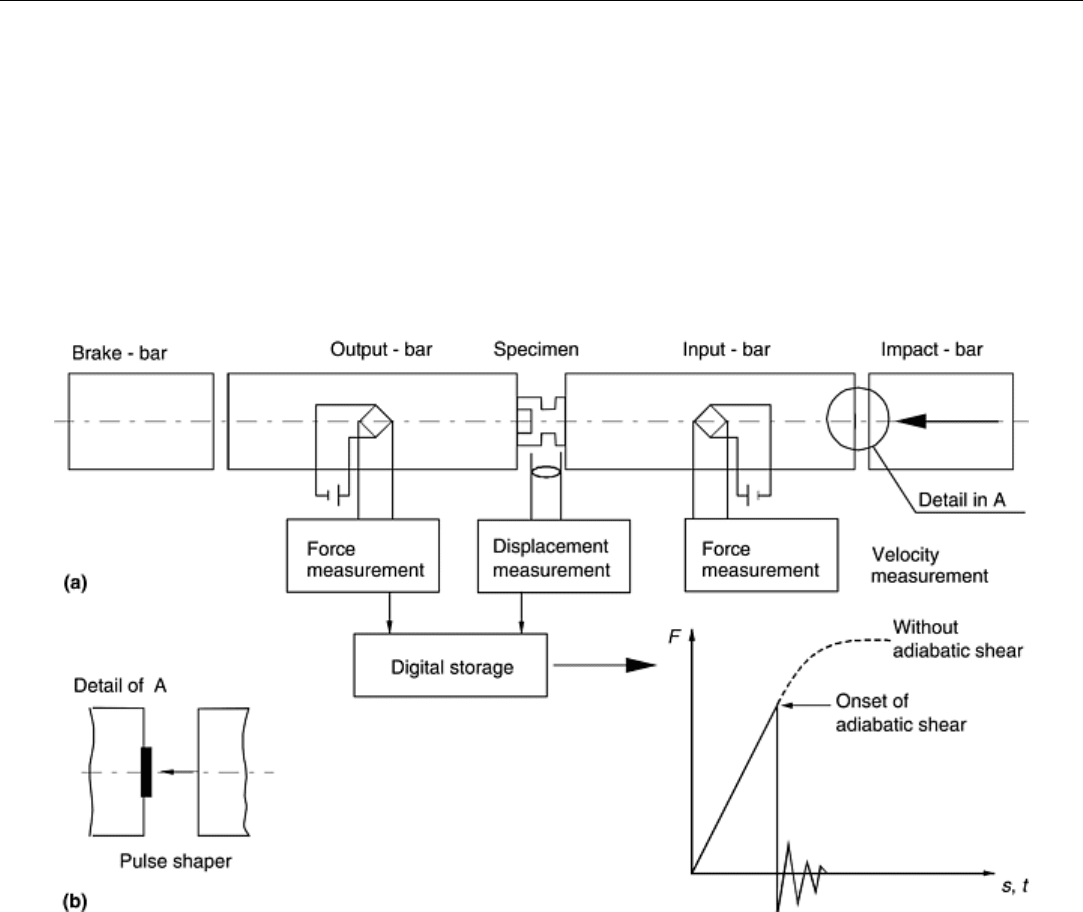
30. J.H. Beatty, L.W. Meyer, M.A. Meyers, and S. Nemat-Nasser, Formation of Controlled Adiabatic Shear
Bands in AISI 4340 High Strength Steel, Shock Wave and High-Strain-Rate Phenomena in Materials,
M.A. Meyers, L.E. Murr, and K.P. Staudhammer, Ed., Marcel Dekker, 1992, p 645–656
31. S. Nemat-Nasser, J.B. Isaacs, and J. Starrett, Hopkinson Techniques for Dynamic Recovery
Experiments, Proc. R. Soc. (London) A, Vol 435, 1991, p 371–391
High Strain Rate Shear Testing
Test Setup and Operation
The test setup (Fig. 7a) (Ref 19, 30) is a specimen placed between the input and output bars. To reduce ringing
effects during the shear test, a small lead or copper disc of 3 to 5 mm (0.12 to 0.20 in.) in diameter and 0.25 to
0.5 mm (0.01 to 0.02 in.) thickness is placed in between the striker bar and the input bar (Fig. 7b). This creates
a trapezoidal or ramp-shaped input wave, which reduces the Pochhammer-Chree ringing (Ref 29, 30). The force
applied to the sample is measured by strain gages on the output bar, and specimen displacement is measured
with a precise high-speed electrooptical camera system. The force-time (F-t) and displacement-time (s-t)
signals are recorded, and stress measurements are calculated from the transmitted and reflected elastic waves in
the bars.
Fig. 7 Test setup for shear testing with hat-shaped specimen. (a) Specimen placed between input and
output bar. (b) Detail of pulse shaper
Test Specimen. The specimen is machined from one piece in a cylindrical form and consists essentially of a
tube on one side and a bar on the other side (Fig. 8). The region between the tube and bar section is the shear
area (Fig. 8). To investigate the development of the shear-band formation and to stop the shear displacement at
any desired stage, it is beneficial to use spacer rings of different thicknesses while testing (Fig. 9). This use of
spacer rings allows the manufacturing of one fixed (or standard) specimen geometry for different test levels of
shear displacement. Regarding the thickness of the spacer rings and the cut in width of the hat-shaped specimen
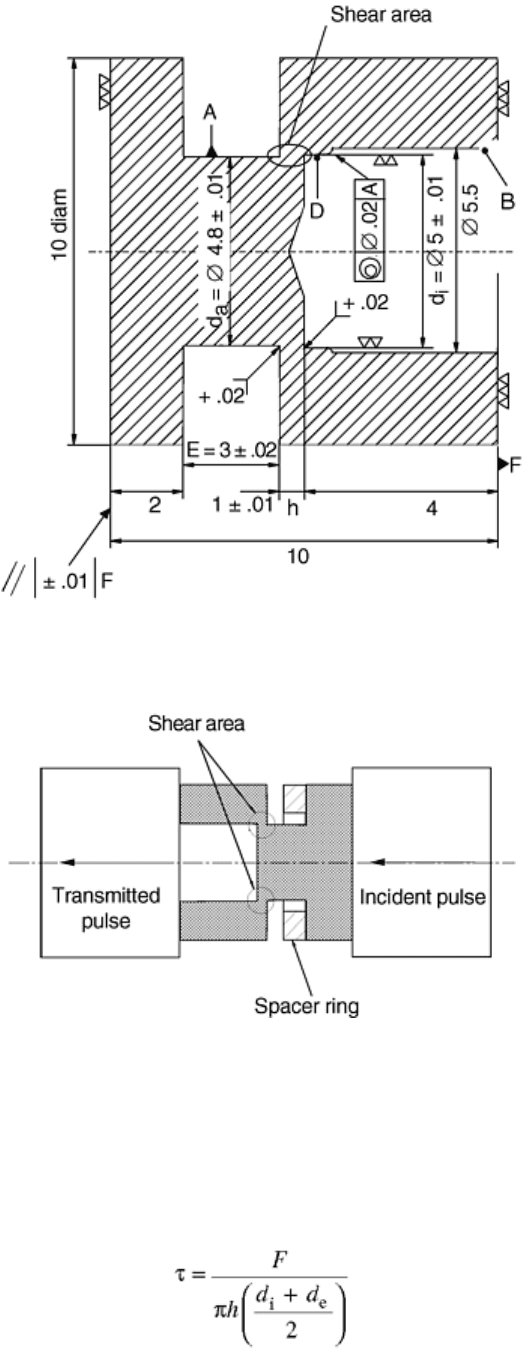
(E in Fig. 8), the possible shear displacement (Δs) is predetermined before the test. The advantage of this
geometry and testing procedure is the symmetry in the left and right regions of the shear zone. Without the
same properties of the material and the same geometry, the shear stresses inside and around the shear zone
would have an asymmetrical distribution (Ref 32).
Fig. 8 Hat-shaped specimen to produce shear deformation under axial compression loading. All
dimensions are in millimeters.
Fig. 9 Detail of loading with spacer ring for controlled shear displacement
The stress state in the plastic deformation region is fairly close to simple shear, and plastic strain is
approximately equal to the ratio between the shear displacement and the thickness of the plastically deformed
band. The stress pulse, produced by impacting the incident bar, generates controlled plastic shear deformation
in the shear area (Fig. 9), while the rest of the specimen undergoes elastic deformation. The mean shear stress,
τ, is estimated by the force, F, divided by the area of resisting shearing:
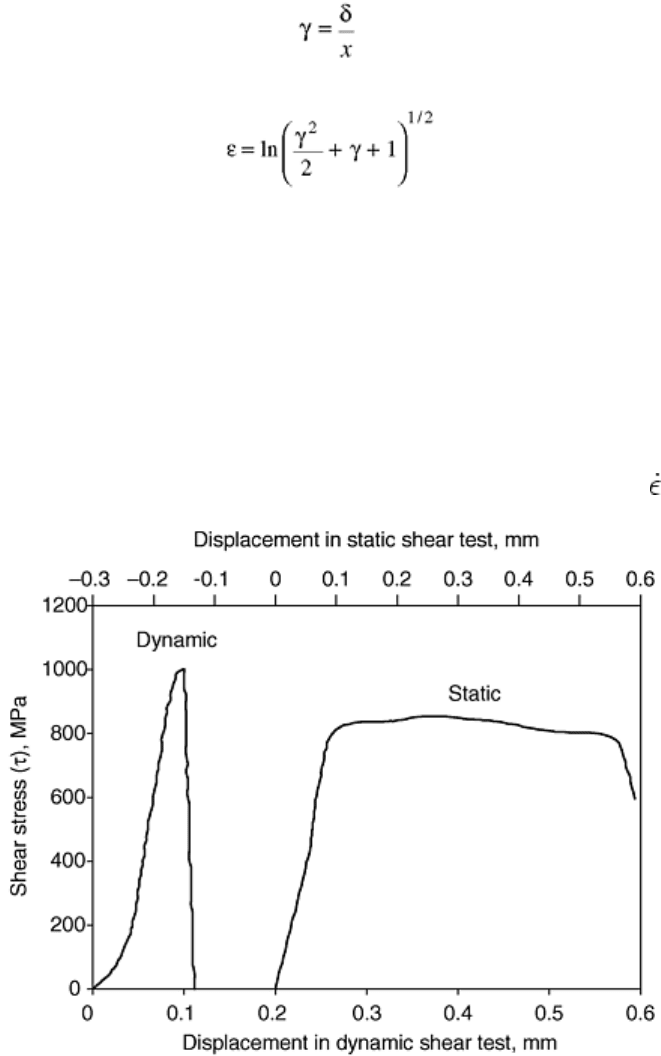
where d
i
and d
e
are the internal and external diameter, respectively, and h is the height of the area of the shear
zone in the axial direction (Ref 27).
The shear strain γ can be determined from the ratio of the controlled displacement, δ, and the width of the shear
band, x:
and as shown by Andrade (Ref 25), the shear strain γ can be related to the uniaxial strain (Ref 33):
Using this test setup, it is possible to study microstructural changes just before and just after the initiation of the
instability, even in the range of Δs/h displacement ratios on the order of a hundred or more (Ref 19, 26, 27, 31).
The onset of localized deformation is evident from the drop in the shear stress displacement diagram. This is
shown schematically in the output graph in Fig. 10. Depending on the properties of materials, the drop may be
very sharp (Fig. 10) or may be less sudden (Fig. 11). The influence of strain rate on strength and deformability
under hat-shaped configurations is shown in Fig. 10. The statically loaded material exhibits a deformability of
about 0.5 mm or 50% shear strain. Under dynamic loading in the same geometry, the deformability is reduced
to low amounts (about 10% of the static values). In general, this can be interpreted as a velocity-induced
“embrittlement,” expressed by the drastic reduction of energy absorption. Locally, very high shear strains are
observed, and the shear strain rates are evaluated by means of micrographs of the measured thickness of the
shear zones and the velocity of shear displacements. For the CrMoV steel, a strain rate = 10
5
- 10
6
s
-1
within
shear band widths of approximately 5 to 10 μm is calculated.
Fig. 10 Shear stress-displacement diagram for a CrMoV steel under dynamic and quasi-static loading.
Source: Ref 19
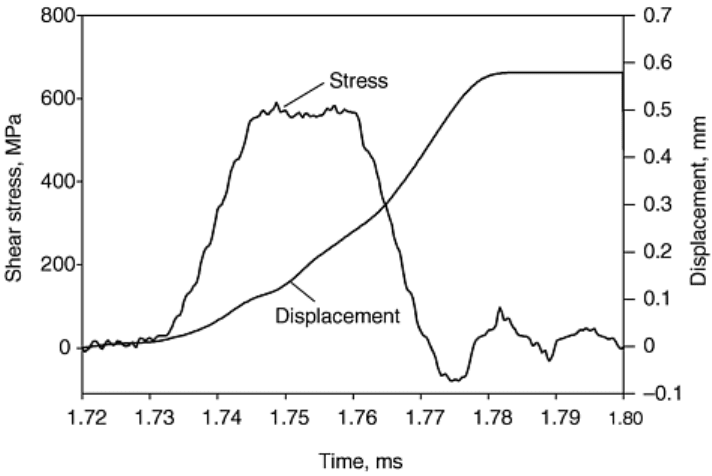
Fig. 11 Shear stress and displacement versus time for rolled homogeneous armor steel
References cited in this section
19. K.-H. Hartmann, H.D. Kunze, and L.W. Meyer, Metallurgical Effects on Impact Loaded Materials,
Shock Wave and High-Strain-Rate Phenomena in Metals, M.A. Meyers and L.E. Murr, Ed., Plenum
Press, 1981, p 325–337
25. U. Andrade, “High-Strain, High-Strain-Rate Deformation of Copper,” Ph.D. thesis, University of
California, San Diego, 1993
26. M.A. Meyers, L.W. Meyer, J. Beatty, U. Andrade, K.S. Vecchio, and A.H. Chokshi, High Strain, High-
Strain Rate Deformation of Copper, Shock Wave and High-Strain-Rate Phenomena in Materials, M.A.
Meyers, L.E. Murr, and K.P. Staudhammer, Ed., Marcel Dekker, 1992, p 529–542
27. M.A. Meyers, G. Subhash, B.K. Kad, and L. Prasad, Evolution of Microstructure and Shear-Band
Formation in α-hcp Titanium, Mech. Mater., Vol 17 (No. 2–3), 1994, p 175–193
29. L.W. Meyer and A. Schrödter, Mechanical Reduction of Oscillations on a Split Hopkinson Bar—A
Simple, but Efficient Method for High Strain Rate Material Testing, ACAM, Canberra, ISBN 0-7334-
0558-4, 1999
30. J.H. Beatty, L.W. Meyer, M.A. Meyers, and S. Nemat-Nasser, Formation of Controlled Adiabatic Shear
Bands in AISI 4340 High Strength Steel, Shock Wave and High-Strain-Rate Phenomena in Materials,
M.A. Meyers, L.E. Murr, and K.P. Staudhammer, Ed., Marcel Dekker, 1992, p 645–656
31. S. Nemat-Nasser, J.B. Isaacs, and J. Starrett, Hopkinson Techniques for Dynamic Recovery
Experiments, Proc. R. Soc. (London) A, Vol 435, 1991, p 371–391
32. T. Pintat, Ph.D. thesis, University Bremen, Germany, 1993
33. M.A. Meyers, U.R. Andrade, and A.H. Chokshi, The Effect of Grain Size on the High-Strain, High-
Strain-Rate Behavior of Copper, Metall. Mater. Trans. A, Vol 26, Nov 1995, p 2881–2893
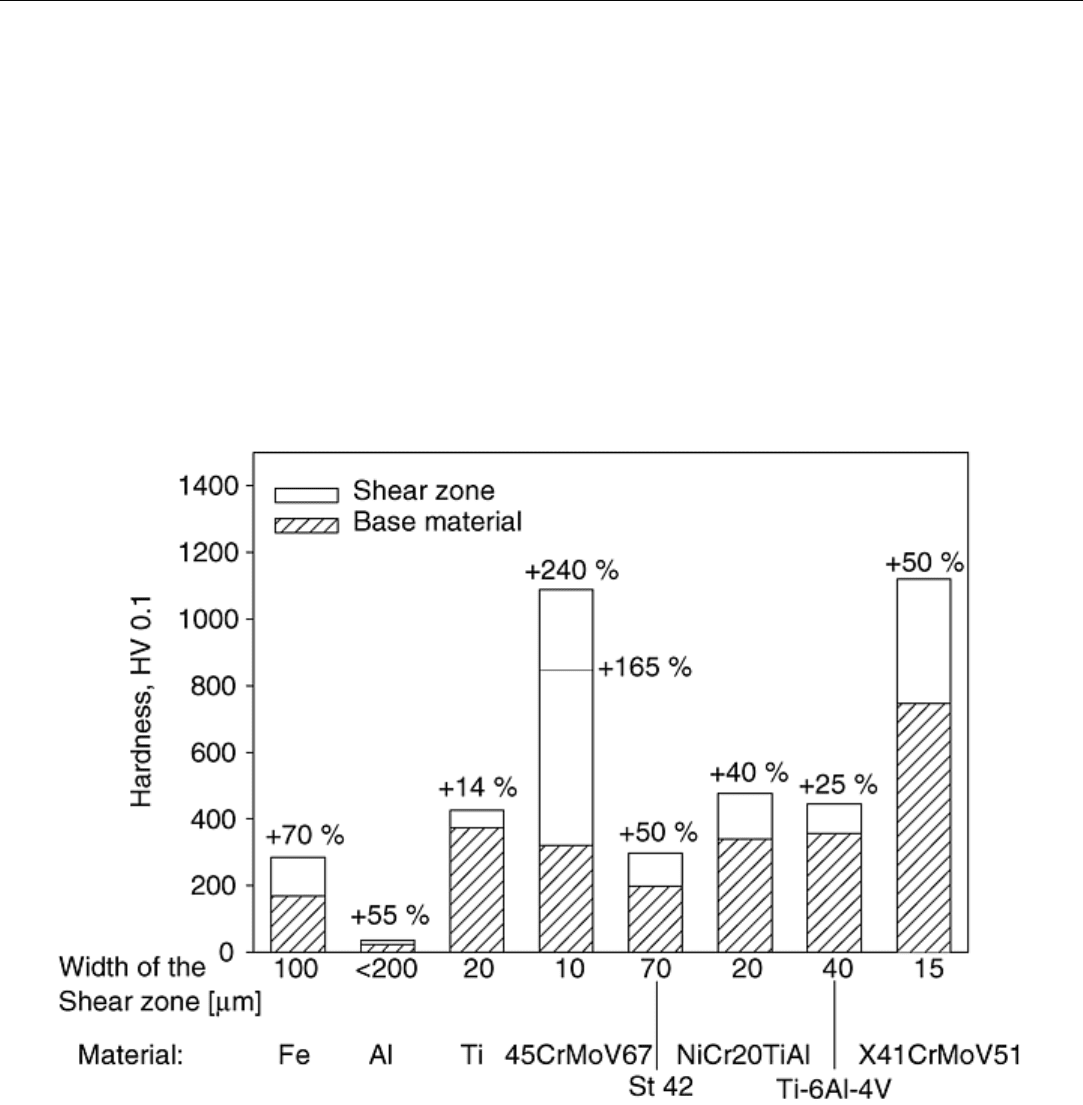
High Strain Rate Shear Testing
Analysis of Shear Zones
The hat-shaped specimen is a suitable configuration to investigate the evolved microstructure and to compare
materials under shear loading. For example, Pintat et al. (Ref 34, 35) analyzed the influence of predeformation
and grain size on the work of deformation during shearing of two plain carbon steels (Ck 10, Ck 45) with 0.1
and 0.45 wt% C content. The energy consumption of the shear process was estimated by the integral of the
force/displacement curve. With increasing predeformation or strain rate, the shear failure occurred at minor
displacements, limiting the absorbed work of deformation. Furthermore, the work of deformation decreases
with increasing shear rate.
Many investigators have also used this specimen to investigate the hardness, size, and shape of shear zones in
different materials (e.g., Fig. 12) and the change in microstructure during shearing (Ref 21, 23, 31, 34, 36, and
37). For example, Beatty et al. (Ref 31) showed that 4340 steels with the same hardness but different
distributions of carbon absorb varying amounts of energy. They analyzed adiabatic shear bands in 4340 steel,
finding a structure of a large number of micrograins with grain sizes between 10 and 50 nm (Ref 31).
Fig. 12 Hardness of base material and hardness and width of shear bands for different materials.
Source: Ref 34
References cited in this section
21. J.A. Hines and K.S. Veccio, Dynamic Recrystallization in Adiabatic Shear Bands in Shock-Loaded
Copper, Metallurgical and Materials Application of Shock Wave and High-Strain-Rate Phenomena,
L.E. Murr, K.P. Staudhammer, and M.A. Meyers, Ed., Elsevier Science B.V., 1995, p 421–428

23. S. Nemat-Nasser, Y.-F. Li, and J.B. Isaacs, Experimental/Computational Evaluation of Flow Stress at
High Strain Rates with Application to Adiabatic Shear Banding, Mech. Mater., Vol 17 (No. 2–3), 1994,
p 111–134
31. S. Nemat-Nasser, J.B. Isaacs, and J. Starrett, Hopkinson Techniques for Dynamic Recovery
Experiments, Proc. R. Soc. (London) A, Vol 435, 1991, p 371–391
34. T. Pintat, L.W. Meyer, and H. Schrader, Properties of Inhomogeneous Shear Zones in Different
Materials, J. Phys., Coll. C5, 1985
35. T. Pintat, B. Scholz, H.D. Kunze, and O. Vöhringer, The Influence of Carbon Content and Grain Size on
Energy Consumption during Adiabatic Shearing, J. Phys., Coll. C3, 1988, p 237–244
36. M.A. Meyers, L.W. Meyer, K.S. Vecchio, and U. Andrade, High Strain, High-Strain Rate Deformation
of Copper, J. Phys. (France) IV, Coll. C3, 1991, p 11–17
37. K. Minnaar and M. Zhou, An Analysis of the Dynamic Shear Failure Resistance of Structural Metals, J.
Mech. Phys. Solids, Vol 46 (No. 10), 1998, p 2155–2170
High Strain Rate Shear Testing
Drop-Weight Compression Shear Testing
L.W. Meyer and L. Krüger, Materials and Impact Engineering at Technical University Chemnitz and
Nordmetall GbR, Germany
The distribution of stress and strains in materials is often inhomogeneous when materials are subjected to high
strain rates and strains in various situations such as high-speed cutting, forging processes, ballistic impact, and
crash behavior of structures. These very complex loading conditions at high strain rates may lead to localized
regions of increased shear deformation (Fig. 13); when heat cannot be dissipated at high strain rates, adiabatic
shear bands may develop, depending on the strain rate and the thermal properties of a material. For example,
titanium alloys are very susceptible to adiabatic shear failure even under uniaxial dynamic compression
loading. In contrast, sintered or sintered and swaged tungsten alloys are less sensitive to adiabatic shear failure
(Ref 38), although shear localizations are observed in the tip of tungsten penetrators. Thus, conditions exist
where even tungsten alloys may fail by adiabatic shear.
